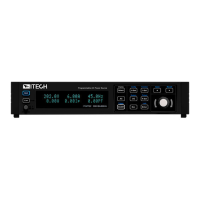SCPI Command Introduction
Copyright© Itech Electronic Co., Ltd. 3
by using a root specifier as follows:
PROTection:CLEAr;:STATus:OPERation:CONDition?
The following message shows how to combine commands from different
subsystems as well as within the same subsystem:
POWer:LEVel 200;PROTection 28; :CURRent:LEVel 3;PROTection:STATe ON
Note the use of the optional header LEVel to maintain the correct path
within the voltage and current subsystems, and the use of the root
specifier to move between subsystems.
Including Common Commands
You can combine common commands with subsystem commands in the
same message. Treat the common command as a message unit by
separating it with a semicolon (the message unit separator). Common
commands do not affect the header path; you may insert them anywhere
in the message.
VOLTage:TRIGgered 17.5;:INITialize;*TRG
OUTPut OFF;*RCL 2;OUTPut ONIT872X-3X SCPI Communication protocol 17
Case sensitivity
Common commands and SCPI commands are not case sensitive. You
can use upper or lowerfor example:
*RST = *rst
:DATA? = :data?
:SYSTem:PRESet = :system:preset
Long-form and short-form versions
A SCPI command word can be sent in its long-form or short-form version.
However, the short-form version is indicated by upper case characters.
Examples:
:SYSTem:PRESet long-form
:SYST:PRES short form
:SYSTem:PRES long-form and short-form combination
Note that each command word must be in long-form or short-form, and
not something in between.
For example, :SYSTe:PRESe is illegal and will generate an error. The
command will not be executed.

